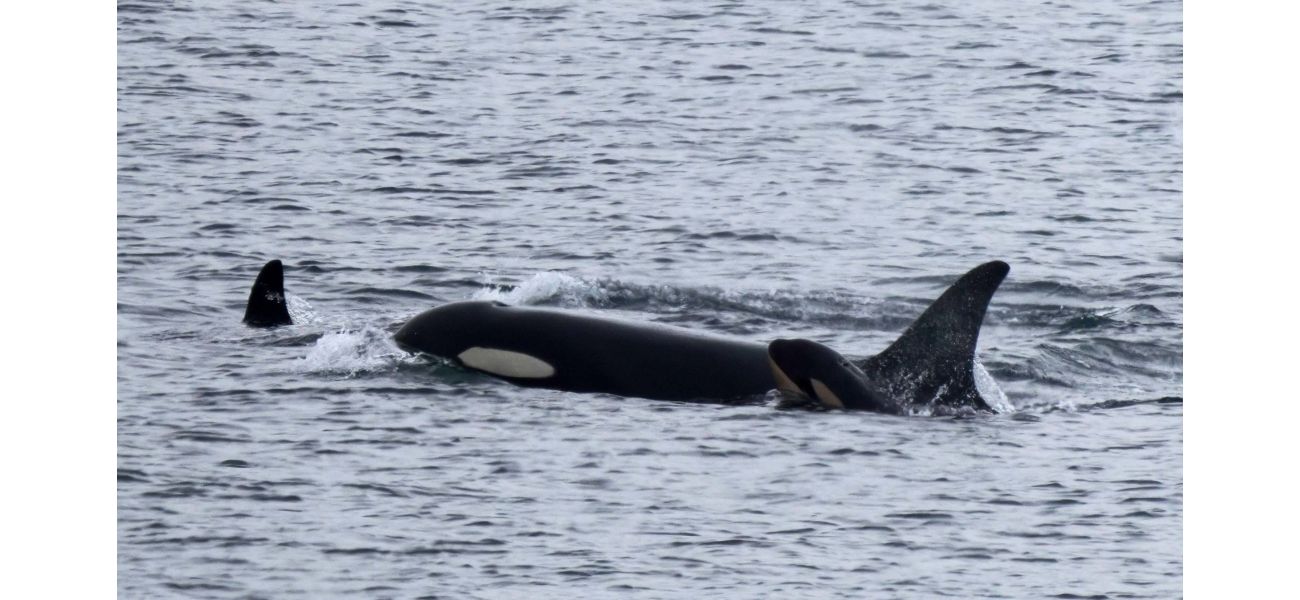Orca mourned her calf for 17 days before welcoming a new baby.
Orcas grieve, but one who carried her dead calf for 17 days has new baby, says researcher Michael Weiss of the Center for Whale Research.
December 25th 2024.

Recently, it was reported that the orca known as Tahlequah, or J35 to researchers, who captured the hearts of many when she swam with her dead calf for 17 days in a display of apparent grieving, has given birth to a new baby. Michael Weiss, the research director of the Center for Whale Research, shared the exciting news that the calf was first spotted on December 20th, swimming with the rest of J pod in the Puget Sound area.
At first, there was some uncertainty about the identity of the calf, but on Monday, scientists and researchers were able to confidently confirm that Tahlequah was indeed the mother and the calf, now known as J61, was her newborn. This confirmation was made possible by a nature enthusiast and photographer who captured the calf in photos, without even realizing it at first. They shared, "My first reaction to seeing the calf was complete shock. I was just looking through my photos and noticed a much smaller dorsal on one of them." As they looked through the series of photos, they realized that it was a very tiny calf, much smaller than any of the known young ones in the group. It was a new calf, traveling with Tahlequah, the "spark whale" that had started their obsession with orcas.
The Center for Whale Research also shared on Facebook that they were able to photograph the calf's underside, confirming that it was a female. This is not Tahlequah's first baby, as she had a known baby, J57, in 2020, two years after the incident that made her famous. She is also a mother to another orca, J47.
While this news is certainly joyous and hopeful, researchers are still concerned about the Southern Resident killer whale population. They are listed as endangered in Canada and are considered one of the most critically endangered populations of marine mammals in the USA. The Center for Whale Research expressed concern about the calf's health based on the behavior of both Tahlequah and J61, mentioning that the first year of a calf's life is always risky and that they hope Tahlequah can keep J61 alive during these difficult early days.
There have been some worrying behaviors observed concerning the calf, such as being pushed around on Tahlequah's head and not looking lively. The Orca Conservancy also shared their concerns, stating that "calf behavior is not fully understood." All of this serves as a reminder that the recovery of salmon stocks is crucial for the survival and growth of the Southern Resident population. In the late 1970s to mid-1990s, the population peaked at 98 animals, but this year's census counted only 73 whales. As the Center for Whale Research stated, "Every single birth counts, and these whales need enough fish to be able to support themselves and their calves." The Southern Resident killer whale population relies on ample access to their main food source, salmon, to survive and thrive.
At first, there was some uncertainty about the identity of the calf, but on Monday, scientists and researchers were able to confidently confirm that Tahlequah was indeed the mother and the calf, now known as J61, was her newborn. This confirmation was made possible by a nature enthusiast and photographer who captured the calf in photos, without even realizing it at first. They shared, "My first reaction to seeing the calf was complete shock. I was just looking through my photos and noticed a much smaller dorsal on one of them." As they looked through the series of photos, they realized that it was a very tiny calf, much smaller than any of the known young ones in the group. It was a new calf, traveling with Tahlequah, the "spark whale" that had started their obsession with orcas.
The Center for Whale Research also shared on Facebook that they were able to photograph the calf's underside, confirming that it was a female. This is not Tahlequah's first baby, as she had a known baby, J57, in 2020, two years after the incident that made her famous. She is also a mother to another orca, J47.
While this news is certainly joyous and hopeful, researchers are still concerned about the Southern Resident killer whale population. They are listed as endangered in Canada and are considered one of the most critically endangered populations of marine mammals in the USA. The Center for Whale Research expressed concern about the calf's health based on the behavior of both Tahlequah and J61, mentioning that the first year of a calf's life is always risky and that they hope Tahlequah can keep J61 alive during these difficult early days.
There have been some worrying behaviors observed concerning the calf, such as being pushed around on Tahlequah's head and not looking lively. The Orca Conservancy also shared their concerns, stating that "calf behavior is not fully understood." All of this serves as a reminder that the recovery of salmon stocks is crucial for the survival and growth of the Southern Resident population. In the late 1970s to mid-1990s, the population peaked at 98 animals, but this year's census counted only 73 whales. As the Center for Whale Research stated, "Every single birth counts, and these whales need enough fish to be able to support themselves and their calves." The Southern Resident killer whale population relies on ample access to their main food source, salmon, to survive and thrive.
[This article has been trending online recently and has been generated with AI. Your feed is customized.]
[Generative AI is experimental.]
0
0
Submit Comment





